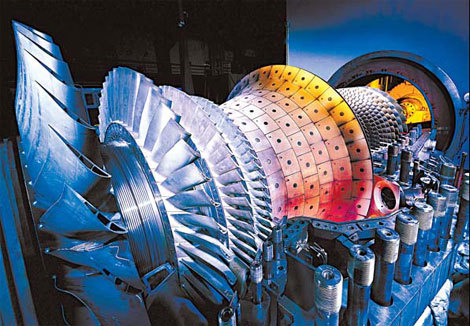With its innovative and advanced solutions and applications, Siemens is highly committed to providing China with an environmentally compatible and reliable energy supply. And it strongly supports the Chinese government in building a society focused on sustainable development.
 |
| A power generation turbine produced by Siemens |
Climate change is probably the greatest and most demanding challenge that confronts mankind today. To counteract global warming and guarantee economic growth and prosperity in the future, energy must be generated and utilized in an environmentally and climate-friendly way.
As China continues to rapidly develop, energy demand will continue to increase. That is why during the 11th Five-Year Plan (2006-10) the government implemented initiatives to reduce per-unit GDP energy consumption by 20 percent by 2010.
In the near future, the big question will be how to use energy more efficiently for a better tomorrow.
Technological innovation
For the last 160 years, Siemens has been answering tough questions just like this. Today, Siemens' solutions lie in technological innovation. Energy efficiency plays a major role in meeting current challenges, including energy conservation and limiting greenhouse gas emissions. Siemens is strongly supporting the Chinese government in its search for ways to achieve an environmentally compatible and reliable energy supply.
In the area of environmental and climate protection, the company holds some 30,000 patents. These inventions create above-average opportunities for long-term growth. Siemens invests more than 2 billion euros (US$2.7 billion) a year in eco-friendly technologies. Dr. Richard Hausmann, president and CEO of Siemens China, announced that Siemens-China will invest 5 billion yuan in central China to develop energy conserving technology and will generate 4 billion euros ($5.4 billion) in orders from its portfolio in 2010 in consideration of China's goal of green GDP.
The comprehensive portfolio includes solutions for nearly every environmentally relevant field of power generation, transmission and consumption - buildings, lighting, transportation and industry - as well as environmental technologies such as water purification and air pollution controls. Independent auditors PricewaterhouseCoopers have reviewed and confirmed the portfolio's revenues and CO2 savings for 2007 as well as the methods Siemens used to calculate them.
Nearly all Siemens divisions are contributing to the company's environmental portfolio. Gas turbines, energy-efficient lighting systems, the modernization of old power plants, wind power systems and eco-friendly trains were the biggest contributors to Siemens' CO2 savings in fiscal 2007. The portfolio also includes products from the company's healthcare sector - for example, the Somatom Definition computed tomography scanner that consumes 30 percent less energy per examination and contains 80 percent less lead than its predecessor.
In China, Siemens green technologies are widely applied. For instance, the Huaneng Shanghai power plant, equipped with three sets of Siemens advanced gas turbines, was awarded the best gas and steam hybrid power plant in Asia in 2007. It plays a large role in supplying power at low cost with reduced CO2 emissions to the Shanghai area during peak demand. Currently under construction is a 1,400-km high-voltage DC transmission system between Yunnan and Guangdong. When this system goes online in mid 2010, it will be the first in the world to transmit electricity at a DC voltage of 800 kV. During power usage, Siemens variable-speed drives with frequency converters reduce the electricity consumption of pumps and fans by up to 60 percent. The new Siemens headquarters in Beijing and Shanghai, with a green design, use around one-third less energy than a comparable office building in China.
Renewable energy
Also in the renewable energy area, Siemens technologies make mass utilization possible in China. Wind energy is playing an ever-greater role in power generation worldwide. As China seeks renewable alternatives to fossil fuels, in February 2006, Winergy Drive Systems (Tianjin) Co Ltd (WDST) a subsidiary of Winergy, the world's only provider of complete drive systems for wind energy, was launched by Siemens in Tianjin. With its state-of-the-art production facilities, WDST is anticipated to expand in the near future to meet the rapidly growing demand of the rising Chinese wind turbine market.
To address water source shortage problems, Siemens China provided a cutting-edge membrane bioreactor system to Beixiaohe Wastewater Treatment Plant, which supplies recreational water and reuse water for the Olympic Park and surrounding areas in Beijing. Compared with conventional wastewater treatment technology, the innovative membrane bioreactor has less treatment stages and higher removal efficiency. With this advanced technology, the plant increased its capacity by 150 percent without occupying more space.
Siemens also designs energy-efficient and environmentally friendly solutions for consumers, such as light-emitting diodes that use 80 percent less electricity than light bulbs and have a service life that is 50 times longer. Compared to 1993 models, today's washing machines use 35 percent less electricity and 46 percent less water.
No other company worldwide can offer its customers such a broad portfolio of economical and ecological technologies. Siemens is fully committed to environmental protection and will continue to make every effort to meet the challenge of climate change.
(China Daily October 24, 2008)